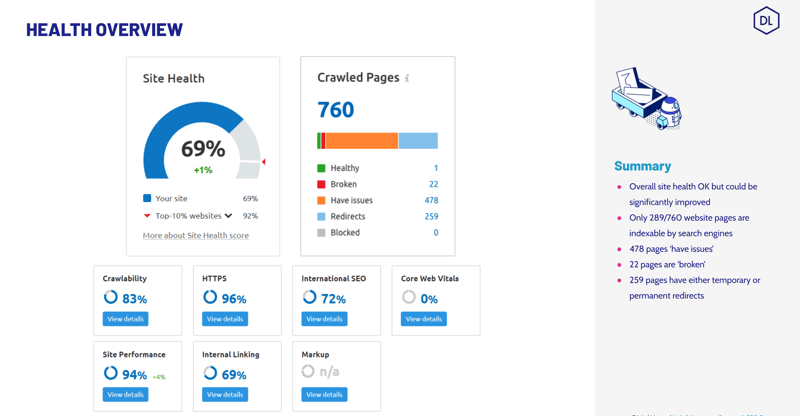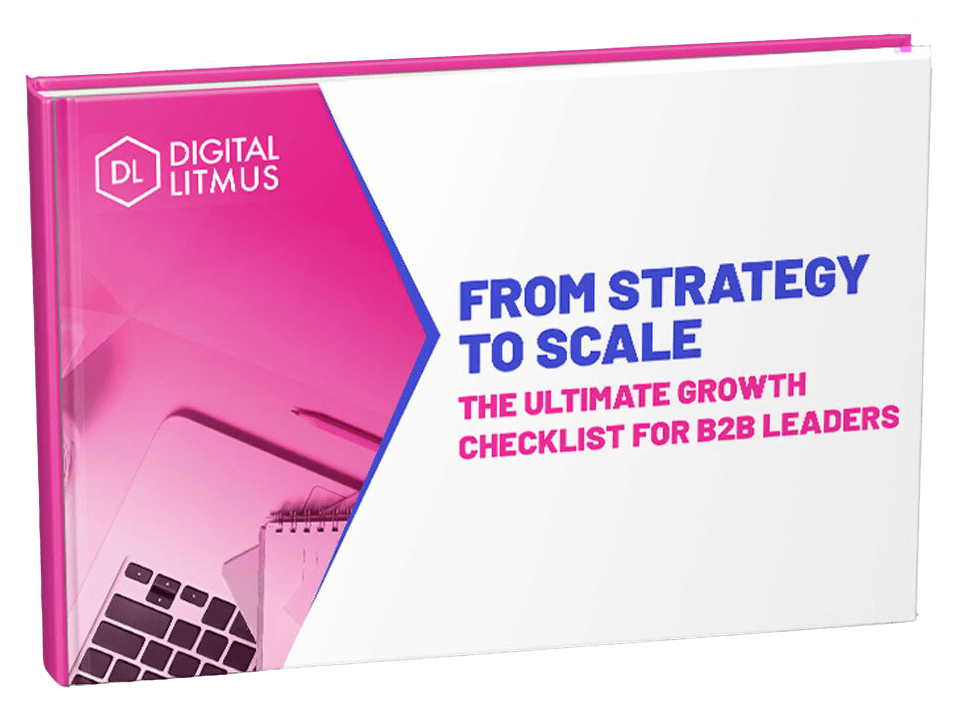When it comes to demand generation, bottom-line growth and successfully building your company’s credibility, the impact for SMEs of strategic and well-thought-through content is unmatched.
By building and executing a B2B content strategy centred on detailed buyer personas and clear positioning, you are able to consistently talk to the ongoing needs and challenges of your ideal customers.
In turn, this accelerates your ability to rank in search engines for high-intent terms and drive traffic. It builds faith among your potential prospects that you understand their situation. And it helps you to convert leads into customers more often, giving you a solid platform for long-term growth.
If you’re an SME marketer that wants to help your team produce content that gets results this blog is for you. Perhaps you’re questioning whether you can produce an effective B2B content strategy in-house or need to work with a content strategy agency. If so, this post will give you everything you need.
We’ll cover:
- The most common challenges in producing a B2B content strategy
- Five essential components of a good B2B content strategy
- In detail - the full Digital Litmus B2B content strategy framework.
Creating a Content Strategy for B2Bs is Challenging
There’s no hiding from it. If you’re an SME with limited resources, devising and applying B2B content strategies is far from straightforward. Where do you find the time? How can you fund any external suppliers? But they are not the only challenges. Others include:
- Limited in-house skills and expertise in creating the kind of content that performs consistently in terms of both traffic and demand generation.
- Little understanding on the buyer’s journey, which can often be significantly more complex in B2B compared to B2C.
- A lack of differentiation in crowded markets where larger, more established companies may hold a significant advantage.
- Restricted budget for measurement tools and technologies, making it more difficult to assess what is working and what is missing the target.
With some or all of those challenges likely to exist in any SME, it’s critical to make sure your content strategy is the best it can be.
5 Components of a Good B2B Content Strategy
Getting clear about how to devise an effective content strategy for B2B involves firstly understanding the different values each strategy needs. That’s why we always recommend ensuring your content strategy is:
- Customer focused, with laser-like attention on the needs and pain points of your target audience. Your content should answer your customers’ challenges, help them to understand more about their situation, and be well planned to offer advice at every stage of the customer journey.
- Aligned with your business goals, which in turn should be clearly defined and measurable, regardless of whether they refer to prospects, customers, profits, or brand awareness.
- Data driven, with clear analyses used to inform your strategy and ongoing performance monitoring helping you to make the changes necessary to optimise your results.
- Consistent and cohesive, with tone, voice and message all recognisable across all your company’s output. This helps to build a strong brand identity at speed.
- Adaptable in the facing of evolving markets, technologies, and customer needs. Experimentation and iteration should be embraced, not feared.
The Digital Litmus B2B Content Strategy Framework
Over many years of working with B2B SMEs operating in a range of different sectors, we have developed a consistently successful method for creating content strategies that deliver demand generation results.
It has been refined through the real-world data we have collected with our clients. And it has been proven time and time again to deliver the kind of results B2B companies need to secure their long-term future.
We call this approach our B2B content strategy framework.
It consists of five major stages, each of which contains tightly defined tasks and processes. The major stages are:
- Goal setting
- Content audit
- SEO audits
- Competitor analysis
- Content strategy and roadmap development
Don't let your content fall flat. Let's collaborate to create valuable, relevant, and consistent content that will attract and retain your target audience. Learn more about our content marketing services.
Stage 1 - Goal Setting
Before we can plan any B2B content strategy, we have to be clear on what we are trying to achieve. So we start with understanding your overall business objectives. Because only when they are clear can we devise a content plan that helps you to achieve your larger goals.
Stage 2 - Content Audit
In this stage, our first task is to complete a thorough content inventory. By listing all of the pages on your website and categorising them by content type, we can start to understand the existing landscape.
We’ll also check the quality of that content, checking if it is SEO optimised (effective keywords, meta tags, recommended word length) and if the content is accessible and user friendly.
Next, we’ll analyse the relevance of your existing content. Your site may be large, but if most of your content is not speaking to your target personas or reflecting the common challenges your audience faces, it is unlikely to perform well. It’s also important to check all published content is still accurate and up-to-date, and that any necessary revisions are made quickly.
Our third task in this stage is to check for content consistency. Is there a clear tone of voice? Does your written material adhere to a company style guide? Are you aligning your content with the company’s overall brand message? If any of these areas are lacking, we develop a plan to ensure future consistency.
Finally, we consider your levels of content engagement. This involves assessing traffic levels, time-on-page, conversion rates, and bounce rates. As we complete this analysis, we look carefully for any patterns or trends that can help to shape our new strategy. We also develop improvement plans for underperforming content.
Stage 3 - SEO Audit
The next stage of our B2B content strategy framework revolves around search engine optimisation. There are three elements to this: technical SEO, on-page optimisation, and off-page optimisation.

Technical SEO audits are specialist tasks. They include checking your website’s structure and architecture, before delving into a range of other areas including page speed, mobile friendliness, load times, HTTPS encryptions, and SSL certificates. Other areas are also assessed to ensure your website is accessible, responsive across different devices, and that all internal links work as they should.
On-page optimisation involves behind-the-scenes work that helps to ensure your content ranks well in search engines and reaches its intended audience. Title tags and meta descriptions are checked, along with header tags, internal links, and that all images are both high quality and have descriptive alt tags. Each piece of content must be unique, so plagiarism tools may form part of the process here. Finally, we’ll check for appropriate keyword implementation and H1, H2 and H3 use.
Our last task in this stage is off-page optimisation. External links are seen by search engines as a valuable indicator of your content’s quality, so we check those links are both high quality and relevant. We also ensure your content is easily shareable and record any existing social media shares.
Stage 4 - Competitor Analysis
In order to differentiate your business successfully, you must develop a keen understanding of your competitors’ strengths and weaknesses. First we identify your key competitors, before conducting detailed assessments of their online presence and data collection on their existing content.
This helps to set the stage for a detailed content comparison between your own business and your competitors. By identifying where your competitors perform better than you in search, evaluating their best practices and the impact of their content on their overall business performance, we can identify opportunities for differentiation and improvement in your own business. Taking a close look at your competitors can also spark ideas for new content for your business.
-min-1.png?width=800&height=417&name=Fooditude%20Content%20%26%20SEO%20Strategy%20(1)-min-1.png)
Stage 5 - Content Strategy and Roadmap Development
The final stage of the Digital Litmus B2B content strategy framework involves eight different tasks: keyword analysis, topic generation, content clustering, content planning, completing a content inventory, assessing content feasibility, analysing content impact, and creating a content production plan. Many of these tasks happen concurrently to help to form a complete end product.
Keyword Analysis
Keyword analysis is the starting point for getting your content discovered. From a demand generation perspective, we immediately look for relevant high intent, high traffic, low competition keywords and ensure content is created with these in mind. Then we expand out, moving up to middle of the funnel content to support buyers in the consideration stage of the customer journey.
In each subsequently produced content piece, we’ll check those keywords are used enough (but not too much). We’ll also make sure they’re strategically placed in H1s, title tags, and meta descriptions.
Topic Generation and Themes
Topic generation is the process of fleshing out potential topics that are directly relevant to your target personas. The sweet spot is finding topics that interest your target audience, are relatively straightforward to produce content about, and that help you to achieve both your content and overall business objectives.
Themes are developed to ensure that the core positioning and opinions of a business are weaved into all pieces of content, helping it stand out from competitors.
-min-1.png?width=800&height=418&name=Fooditude%20Content%20%26%20SEO%20Strategy%20(5)-min-1.png)
Content Clustering
When we’ve finished collating a list of potential topics, we’ll embark on the process of content clustering: grouping topics together into coherent clusters that we can then assess for their potential impact on your prospects and customers. We’ll also spend time working out whether those clusters should be covered through blogs, videos, white papers, infographics, or anything else.
Content Planning and Creation
With that detail in place, we can move on to content planning and the creation of a content calendar. As part of this process, we’ll assess where each piece of content currently stands in the production process and how we can ensure each piece is completed as quickly as possible.
Part of that process involves assessing content feasibility, and identifying the stumbling blocks that may prevent any single piece from going live. We try to set target publication dates for each piece in a bid to ensure onward momentum.
We also consider each content piece’s potential impact, both on your target audience and your business goals. These judgments help to determine which content pieces should be published as a matter of urgency.
Content Production Planning
Finally, all this detail comes together in the creation of an overall content production plan. This plan allocates resources, budgets and deadlines to each piece of content. Any necessary final adjustments are made at this stage before the production plan moves from theory to live actions.
A Good B2B Content Strategy is Essential for SMEs
In this piece, we’ve outlined the essential elements of an effective B2B content strategy and revealed for the first time the details of our own content strategy framework. This should give you a thorough understanding of what is needed to succeed in demand generation.
But for most SMEs, understanding won’t be enough. Leveraging the experience and knowledge of a dedicated B2B content strategy agency is the final piece of the jigsaw, taking your plans from vague theory to an implemented strategy that is driving measurable and real-world business results week after week, month after month, year after year.

Are you a B2B company looking to accelerate growth?
Our connected sales, marketing, and HubSpot agency services might be just the ticket. Get in touch for your free growth assessment to find out how you can accelerate business growth today.
%20(1).jpg)




